Is there anything more frustrating than seeing a plethora of ripe, golden fruit hanging just above your head, yet you can’t pick any to eat?
Summer is the season for fruit-bearing trees. At a time when fruit prices soar due to inflation, what could be more annoying than seeing an abundance of juicy mangoes, longans, lychees, and jackfruits dangling right in front of you, but you cannot pick any?
However, this is the harsh reality in many provinces of southern China. In fact, there is a saying circulating on the internet that goes: “If you haven’t had a ripe mango fall on your head, you are not a true Guangxi person.”
This is because in the cities of this province, the trees planted along the roads are all fruit trees. Jackfruit, mango, longan, lychee… most of them bloom and bear fruit in the summer, giving residents a view of a supermarket of fruit hanging right above their heads whenever they walk the streets.
Thinking about this, many might dream of a beautiful paradise where fruit is everywhere outside, and they can simply climb and pick or pluck fruit whenever they like.
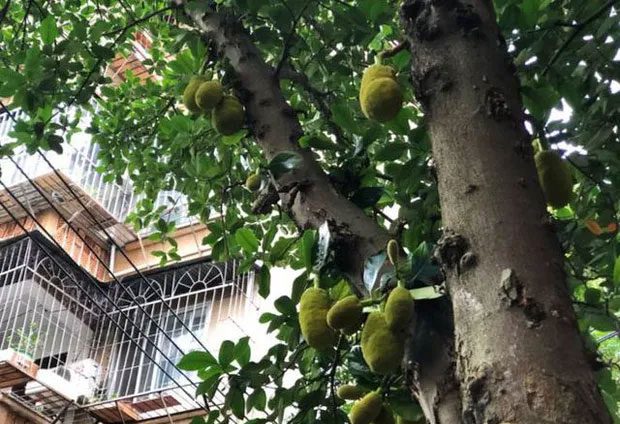
Stopping by the sidewalk, looking up at these jackfruits, what would you feel?
However, reality may not be as beautiful as imagined.
Indeed, in Guangxi, Guangdong, Fujian, Hainan, and other southern provinces of China, fruit trees are often used as urban greening plants. Among them, Nanning stands out as a prefecture-level city and the capital of the Guangxi Zhuang Autonomous Region.
Since the 1970s, Nanning has implemented a greening policy by planting fruit trees along the streets.
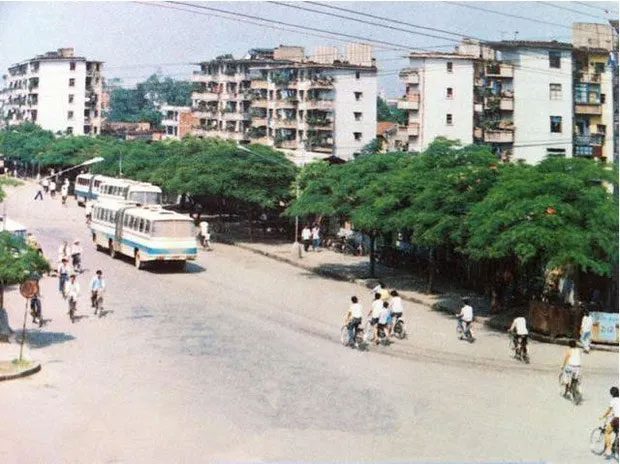
Street scene in Nanning during the 1980s.
At that time, Nanning was still in the early stages of urbanization, with more bicycles than cars on the roads. Therefore, there was no issue with large-scale fruit tree planting along the streets. When the fruits ripened, the urban maintenance department would arrange for workers to harvest them collectively.
In other words, half a century ago, when strolling along the streets of Nanning, the locals could directly pick a ripe mango to eat.
Seeing the initial benefits, Nanning gradually increased its planting of fruit trees. In addition to the four common types of trees—jackfruit, mango, sour plum, and peach—there are now also lychee, longan, kumquat, guava, starfruit, and jujube… The entire city in summer resembles a giant fruit supermarket.
In terms of quantity, peaches are the most dominant fruit trees, with around 30,000 trees in the urban area of Nanning alone. Additionally, there are about 6,000 mango trees and around 1,000 jackfruit trees.
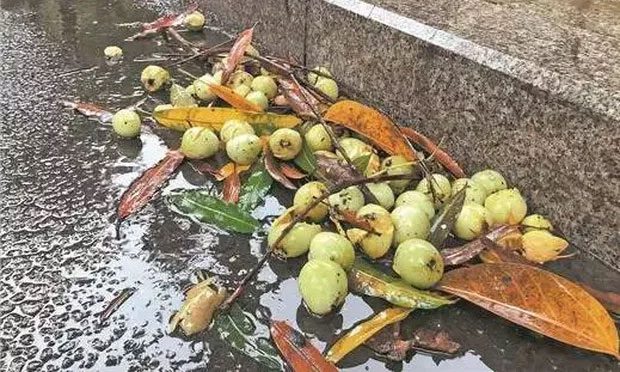
Mangoes fallen by the roadside in Nanning after a rain.
However, with urbanization, the dream of “free fruit” is gradually fading.
Initially, as urbanization progressed, the number of cars on the roads increased exponentially, along with industrial emissions, car fumes, and dust from construction in the city directly affecting the roadside trees. As a result of exposure to various pollutants, the trees along the streets gradually wilted, their leaves became dull, and the fruits also deteriorated. Observing the sorry state of the fruit trees, many people said they no longer wanted to pick and eat them as before.
Moreover, importantly, these fruits no longer taste as good as they used to. Mangoes have less flesh, larger seeds, and more fiber, with a sour taste. Jackfruits are similar, with fewer segments, poor flavor, and high acidity. Peaches are not much better. Not to mention, along with the frequent spraying of pesticides to protect the trees from pests, authorities have discovered that these fruits contain residues of heavy metals and pesticides, which can be harmful to human health.
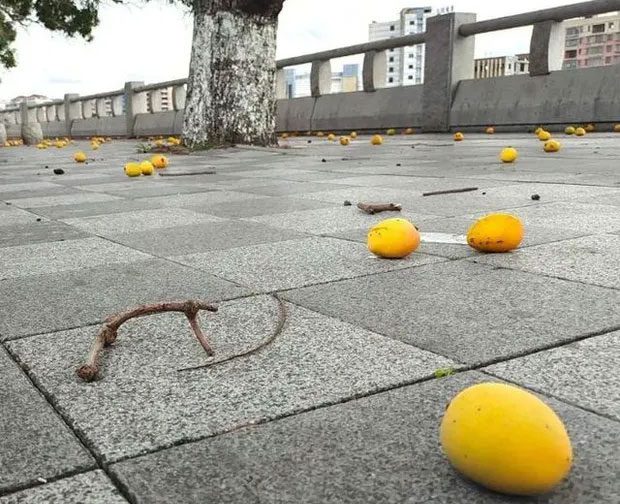
Fruits rolling by the roadside is a typical scene in many southern cities of China
Of course, for fruit trees planted along the roads, producing fruit is not their primary purpose.
As urban greening plants, they hold not only aesthetic value but also ecological significance. Street trees can maintain carbon and oxygen balance, increase humidity in the air, alleviate the “urban heat island effect” in urban areas, and improve the ecological environment. Simply put, if a city is a large dirty fish tank, then the street trees are the garbage collectors within it.
But not every tree can be suitable for urban planting.
To green urban areas, trees need to meet at least three conditions to be selected, or jokingly speaking, “become civil servants and be certified.”
- First, street trees must have a large canopy and provide shade.
- Second, the trees must have high adaptability, good growth, and be pest-resistant.
- Third, they need to withstand pruning and require minimal maintenance.
Peaches, mangoes, and other fruit trees generally meet these conditions. They have dense branches and leaves, which help reduce wind speed and trap dust on the streets. The leaf surfaces of some fruit trees are rough, bumpy, and hairy, with secretions that can absorb dust and harmful gases, playing a role in filtering the air. Densely growing fruit trees also absorb and help reduce noise from city traffic.
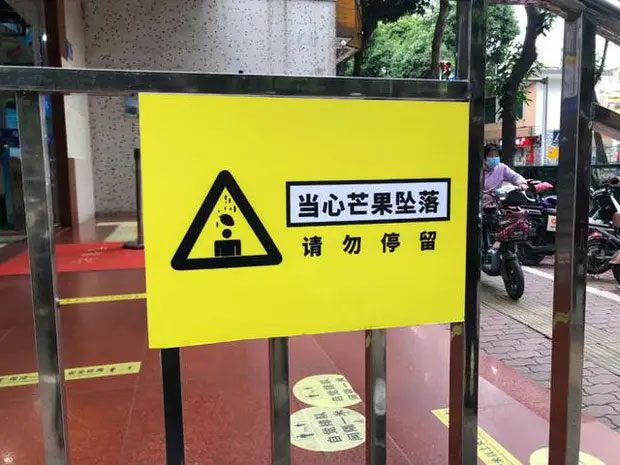
Caution sign “Beware of falling mangoes” by the roadside in Guangzhou, China
However, fruit trees like lychees and longans are not suitable for street planting. Because to be planted along sidewalks, the trees require a height clearance (the distance from the lowest point of the branches to the ground) of about 2.5 to 3 meters, not to mention planting between two lanes of traffic.
Therefore, fruit trees like lychees and longans, with their low canopies, have mostly been planted in dedicated green spaces and recreational areas for residents, such as parks and playgrounds…
However, most fruit trees have a significant drawback when used as urban plants, which is that maintaining them becomes more troublesome. Since the fruits will naturally drop after ripening, a large quantity can pollute the streets, create unpleasant odors, and attract flies and mosquitoes.
Larger fruits, such as mangoes and jackfruits, can even pose a danger to pedestrians, especially during the rainy season from June to July.
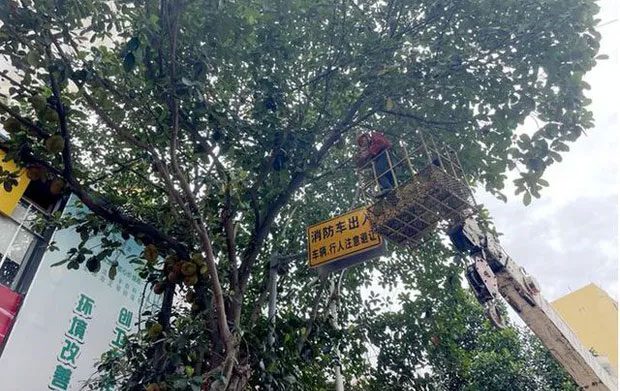
Environmental sanitation workers trimming the branches of a jackfruit tree.
Moreover, harvesting, if done, is also quite labor-intensive.
For example, for lychees or longans, their fruits are relatively small and often drop when ripe, requiring sanitation workers to quickly clean them up. Before the rainy season arrives, almost all the workforce from the environmental sanitation department must mobilize to manually remove large fruits while also trimming dead branches, broken branches, and branches affected by pests. Pesticides also need to be sprayed regularly, as fruit trees particularly attract a variety of pests.
According to a sanitation worker in Nanning, cleaning up fallen fruits is even harder than cleaning up fallen leaves. Because when ripe, the fruits often get bruised and damaged, and cleaning them up sometimes has to be done by hand instead of just sweeping with a broom.
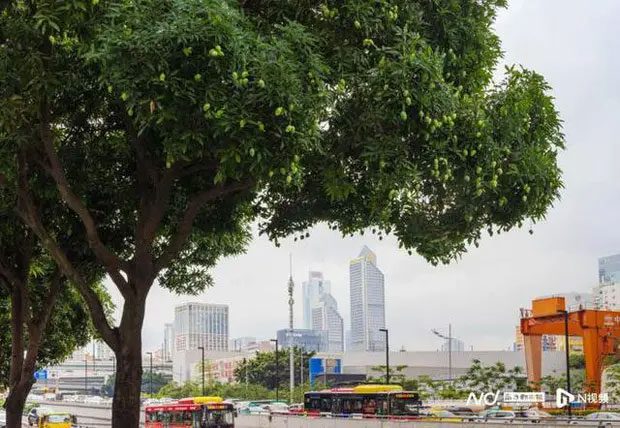
The mango trees by the roadside have gradually become a distinctive urban landscape
Recognizing the arising issues, the Nanning city government has gradually limited the planting of fruit trees and replaced them with traditional urban greenery.
According to a 2011 study on urban greening here, fruit trees currently account for only 12.7% of the total number of green trees, with only peaches and mangoes still being planted along traffic lanes and sidewalk greenery.
Reading this, you might wonder, if the fruit trees by the roadside are not edible and cause too many maintenance hassles, why are they still being planted?
The answer is that besides their role in protecting the urban ecosystem, these characteristic trees are also the face and highlight of a city.
For some areas, trees like mangoes, jackfruits, peaches, and other fruit trees are native species with a long history. They have long been an important part of urban culture.
Moreover, the sight of fruit-laden trees lining the roads, with vibrant hues of yellow and red interspersed with green leaves, creates a distinctive landscape typical of cities in southern China. These trees also symbolize the lush vegetation and bountiful produce of the city. If the fruit trees along the roads were eliminated, that city would lose its unique charm and character.
Therefore, local governments continue to plant fruit trees, even if their fruits are not edible. After all, cities in southern China have the advantage of fertile land, producing high-quality fruits at affordable prices, giving residents a wide variety of choices instead of longing for the fruits growing on the sidewalks.




















































